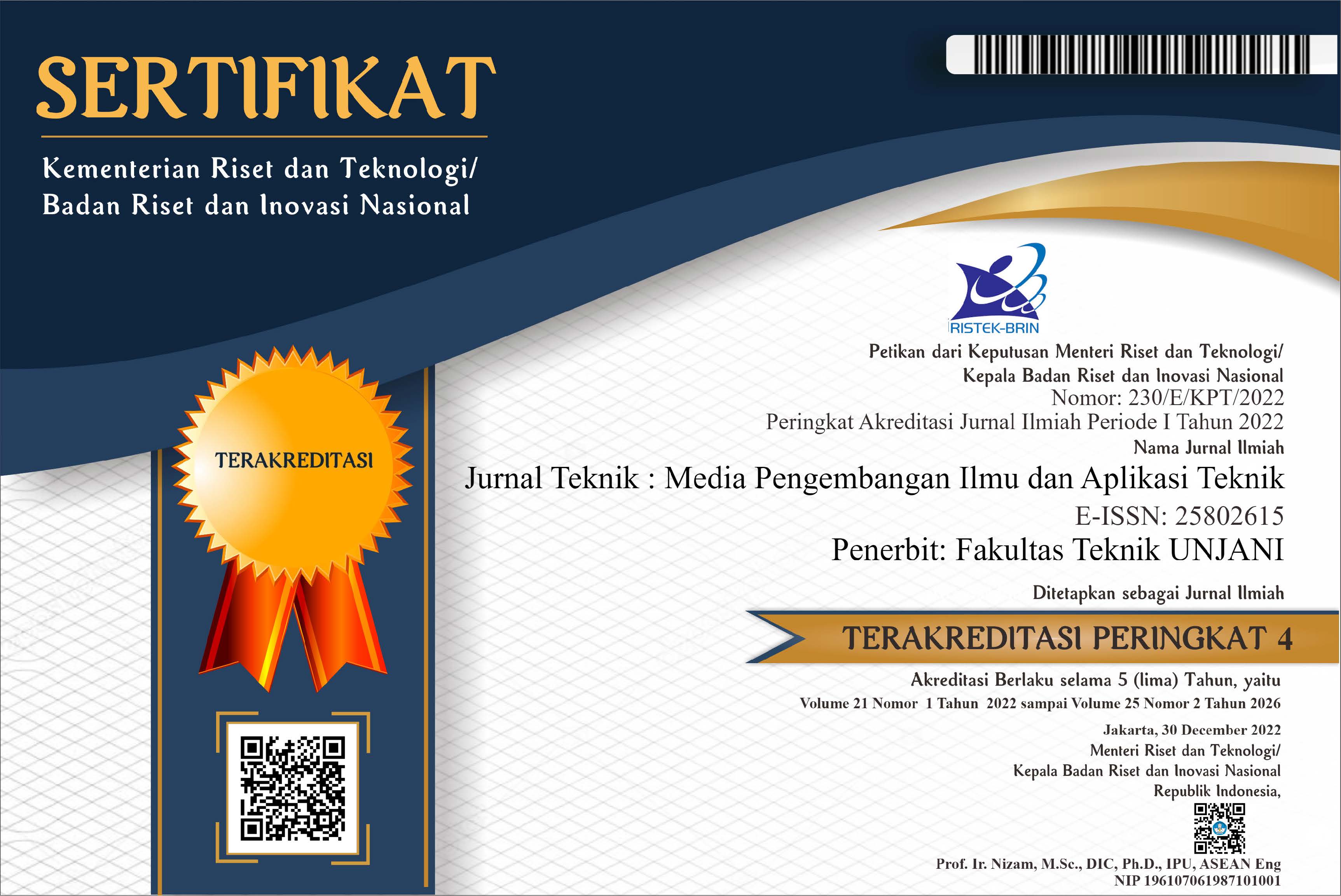Pengaruh Suhu pada Inhibitor Daun Pandan Terhadap Laju Korosi pada Baja SS-304 dalam Larutan Asam HCL 0,1M
DOI:
https://doi.org/10.26874/jt.vol20no1.372Keywords:
SS-304 steel, corrosion rate, natural inhibitor, pandan leavesAbstract
The phenomenon of corrosion cannot be avoided in the use of the metal industry, therefore a corrosion inhibitor is needed to inhibit the corrosion rate of steel. The aim of this research is to obtain natural inhibitors that are effective in inhibiting the corrosion rate. In this study, the sample used is stainless steel which is most often used in everyday life, namely SS (Stainless Steel)-304. Some of the organic or natural inhibitors used in this study is pandan leaves. The variables used were immersion time and temperature. Furthermore, the parameters studied were the corrosion rate of steel and the morphology of SS-304 steel using the SEM test. The results showed that the best corrosion rate and morphology using pandan leaves at a temperature of 60℃ soaked with 0,1 N HCL solution for 5 weeks.
Downloads
References
A. Thorn, A. Adam, T. Gichuhi, W. Novelli, M.A. Sapp. (2006). Improved corrosion control through nontoxic corrosion inhibitors synergies, J. Coat. Technol. 3 (2006) 24–30.
Abd El Haleem, S. M., Abd El Wanees, S., Abd El Aal, E. E., & Farouk, A. (2013). Factors affecting the corrosion behaviour of aluminium in acid solutions. I. Nitrogen and/or sulphur-containing organic compounds as corrosion inhibitors for Al in HCl solutions. Corrosion Science, 68, 1–13. https://doi.org/10.1016/j.corsci.2012.03.021
Abdel-Azim, A. A., Milad, R., El-Ghazawy, R., & Kamal, R. (2014). Corrosion inhibition efficiency of water soluble ethoxylated trimethylol propane by gravimetric analysis. Egyptian Journal of Petroleum, 23(1), 15–20. https://doi.org/10.1016/j.ejpe.2014.02.003
Amin, M. A., & Ibrahim, M. M. (2011). Corrosion and corrosion control of mild steel in concentrated H2SO4 solutions by a newly synthesized glycine derivative. Corrosion Science, 53(3), 873–885. https://doi.org/10.1016/j.corsci.2010.10.022
Antonijevic, M. M., & Petrovic Mihajlovic, M. B. (2015). Copper Corrosion Inhibitors. Period 2008-2014. A Review. International Journal of Electrochemical Science, 10(2), 1027–1053. http://electrochemsci.org/papers/vol10/100201027.pdf
Bentiss, F., Traisnel, M., & Lagrenee, M. (2000). The substituted 1,3,4-oxadiazoles: A new class of corrosion inhibitors of mild steel in acidic media. Corrosion Science, 42(1), 127–146. https://doi.org/10.1016/S0010-938X(99)00049-9
Caliskan, N., & Akbas, E. (2011). The inhibition effect of some pyrimidine derivatives on austenitic stainless steel in acidic media. Materials Chemistry and Physics, 126(3), 983–988. https://doi.org/10.1016/j.matchemphys.2010.11.051
D. Li, F. Wang, X. Yu, J. Wang, Q. Liu, P. Yang, et al., (2011). Anticorrosion organic coating with layered double hydroxide loaded with corrosion inhibitor of tungstate, Prog. Org. Coat. 71 (2011) 302–309, http://dx.doi.org/10.1016/j. porgcoat.2011.03.023
De Souza, F. S., Giacomelli, C., Gonçalves, R. S., & Spinelli, A. (2012). Adsorption behavior of caffeine as a green corrosion inhibitor for copper. Materials Science and Engineering C, 32(8), 2436–2444. https://doi.org/10.1016/j.msec.2012.07.019
de Souza, F. S., & Spinelli, A. (2009). Caffeic acid as a green corrosion inhibitor for mild steel. Corrosion Science, 51(3), 642–649. https://doi.org/10.1016/j.corsci.2008.12.013
F.L. Nie, S.G. Wang, Y.B. Wang, S.C. Wei, Y.F. Zheng. (2011). Dental Mater. 27, 677–683.
Glass, G. K., & Page, C. L. (1991). FACTORS AFFECTING THE CORROSION R A T E OF STEEL IN C A R B O N A T E D M O R T A R S. 32(12), 1283–1294.
Goyal, M., Kumar, S., Bahadur, I., Verma, C., & Ebenso, E. E. (2018). Organic corrosion inhibitors for industrial cleaning of ferrous and non-ferrous metals in acidic solutions: A review. Journal of Molecular Liquids, 256(2017), 565–573. https://doi.org/10.1016/j.molliq.2018.02.045
Gunasekaran, G., & Chauhan, L. R. (2004). Eco friendly inhibitor for corrosion inhibition of mild steel in phosphoric acid medium. Electrochimica Acta, 49(25), 4387–4395. https://doi.org/10.1016/j.electacta.2004.04.030
Hakim, A. Al. (2011). Pengaruh Inhibitor Korosi Berbasiskan Sunyawa Fenolik untuk Proteksi Pipa Baja Karbon pada Lingkungan 0.5, 1.5, 2.5, 3.5% NaCl yang Mengandung Gas CO2. Universitas Indonesia, Depok.
Hye-Young Klose, A. (1997). vapor phase corrosion inhibitors for navy application. 21(3), 295–316.
K.T. Oh, S.U. Choo, K.M. Kim, K.N. Kim, Eur. J. (2005). Orthodontics 27, 237–244.
Karim, A. A. ., & Yusuf, Z. A. (2012). Analisa Pengaruh Penambahan Inhibitor Kalsium Karbonat dan Tapioka Terhadap Tingkat Laju Korosi pada Pelat Baja Tangki Ballast Air Laut. Jurnal Riset Dan Teknologi Kelautan, 10(2), 205–2011. http://repository.unhas.ac.id/bitstream/handle/123456789/4363/8.20ASIS20dan20P.zul20master.pdf?sequence=1
Kayadoe, & Dkk. (2009). Ekstrak daun pandan. 88–96.
Mardhani, & Harmami. (2013). Pengaruh Suhu Terhadap Korosi Baja SS 304 dalam Media 1 M HCL dengan Adanya Inhibitor Kinina. Sains Dan Seni Pomits, 2(2), 2–4.
Mazères, B., Desgranges, C., Toffolon-Masclet, C., & Monceau, D. (2016). Experimental study and numerical simulation of high temperature (1100-1250°C) oxidation of prior-oxidized zirconium alloy. Corrosion Science, 103, 10–19. https://doi.org/10.1016/j.corsci.2015.10.018
Raja, P. B., & Sethuraman, M. G. (2008). Natural products as corrosion inhibitor for metals in corrosive media - A review. Materials Letters, 62(1), 113–116. https://doi.org/10.1016/j.matlet.2007.04.079
Revie, R. W., & Uhlig, H. H. (2008). Definition and Importance of Corrosion. Corrosion and Corrosion Control, 1–8. https://doi.org/10.1002/9780470277270.ch1
Saputra, R. (2011). Studi pengaruh konsentrasi ekstrak the rosella (Hibiscus Sabdariffa) sebagai green corrosion inhibitor untuk material baja karbon rendah di lingkungan NaCl 3,5% pada Temperatur 40 derjat celcius, Roni Saputra, FT UI, 2011. Skrripsi.
Sastri, V. S. (2011). green corrosiom inhibitors. Theory and Practice. Hoboken: John Wiley & Sons, Inc.
Scendo, M. (2007). The effect of purine on the corrosion of copper in chloride solutions. Corrosion Science, 49(2), 373–390. https://doi.org/10.1016/j.corsci.2006.06.022
Shreir, L. L., & Burstein, G. T. (2013). Outline of Chemical Thermodynamics. Corrosion: Third Edition, 2, 20:57–20:75. https://doi.org/10.1016/B978-0-08-052351-4.50145-X
Singh, M. R., & Singh, G. (2012). Hibiscus cannabinus extract as a potential green inhibitor for corrosion of mild steel in 0.5 M H2SO4 solution. Journal of Materials and Environmental Science, 3(4), 698–705.
Soltani, N., Tavakkoli, N., Khayatkashani, M., Jalali, M. R., & Mosavizade, A. (2012). Green approach to corrosion inhibition of 304 stainless steel in hydrochloric acid solution by the extract of Salvia officinalis leaves. Corrosion Science, 62, 122–135. https://doi.org/10.1016/j.corsci.2012.05.003
Sumarji. (2011). Studi Perbandingan Ketahanan Korosi Stainless Steel Tipe Ss 304 Dan Ss 201 Menggunakan Metode U-Bend Test Secara Siklik Dengan Variasi Suhu Dan Ph. Jurnal ROTOR, 4(1), 1–8.
Verma, C., Olasunkanmi, L. O., Ebenso, E. E., Quraishi, M. A., & Obot, I. B. (2016). Adsorption Behavior of Glucosamine-Based, Pyrimidine-Fused Heterocycles as Green Corrosion Inhibitors for Mild Steel: Experimental and Theoretical Studies. Journal of Physical Chemistry C, 120(21), 11598–11611. https://doi.org/10.1021/acs.jpcc.6b04429
Wahyuningsih, A., Sunarya, Y., & Aisyah, S. (2010). Metanamina sebagai Inhibitor Korosi Baja Karbon dalam Lingkungan Sesuai Kondisi Pertambangan Minyak Bumi. Jurnal Sains Dan Teknologi Kimia, 1(1), 17–29.
Yanuar, A. P., Pratikno, H., & Titah, H. S. (2017). Pengaruh Penambahan Inhibitor Alami terhadap Laju Korosi pada Material Pipa dalam Larutan Air Laut Buatan. Jurnal Teknik ITS, 5(2), 8–13. https://doi.org/10.12962/j23373539.v5i2.18938
Additional Files
Published
How to Cite
Issue
Section
License
Copyright (c) 2021 Laras Andria Wardani, Hernowo Widodo, Lisa Adhani, Everlita Sabrina, Amaliah Annisa

This work is licensed under a Creative Commons Attribution-NonCommercial-ShareAlike 4.0 International License.
Penulis yang menyerahkan artikel di Jurnal Teknik: Media Pengembangan dan Aplikasi Teknik untuk keperluan publikasi telah mengetahui bahwa Jurnal Teknik: Media Pengembangan dan Aplikasi Teknik memberikan akses terbuka terhadap konten untuk mendukung pertukaran informasi mengenai ilmu pengetahuan, sesuai dengan penerbitan daring yang berbasis Open Access Journal dan mengikuti Creative Commons Attribution 4.0 International License. Sehingga penulis setuju dengan ketentuan-ketentuan berikut:
1. Penulis memegang hak cipta dan memberikan hak publikasi pertama kepada pihak jurnal dengan pekerjaan secara bersamaan
di bawah Creative Commons Attribution 4.0 International License yang memungkinkan orang lain untuk berbagi pekerjaan
dengan pengakuan kepengarangan karya dan publikasi pertama artikel tersebut di Jurnal Teknik: Media Pengembangan dan
Aplikasi Teknik.
2. Penulis dapat melakukan perjanjian tambahan untuk hak distribusi non-eksklusif artikel yang telah diterbitkan di jurnal ini
(misalnya, posting ke sebuah repositori institusi atau menerbitkannya dalam sebuah buku), dengan mengakui bahwa
publikasi pertama dilakukan di Jurnal Teknik: Media Pengembangan dan Aplikasi Teknik.
3. Penulis diizinkan dan didorong untuk menyebarkan karya mereka secara daring (misalnya, dalam repositori institusi atau
laman web penulis) setelah artikel terbit (proses penerbitan artikel selesai). Hal ini terkait dengan imbas dari pertukaran
informasi yang produktif (Lihat Pengaruh Open Access).












